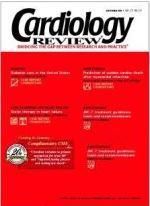Publication
Article
Cardiology Review® Online
Role of ST-segment status in guiding treatment
We will soon celebrate the 100th anniversary of the electrocardiogram (ECG). Although the equipment used has evolved, the fundamental principle of recording the net electrical activity of the heart from the surface of the chest remains the same. As such, the ECG is probably the most durable diagnostic test in modern medicine. As shown by Fu and Armstrong (page 34) in their article on the prognostic value of the ECG at discharge in patients with acute coronary syndromes (ACS), its value remains substantial in the prognosis of unstable coronary disease.
ST-segment depression at any time (even, presumably, in the presence of left ventricular hypertrophy and other possible causes of altered repolarization) has long been recognized as a predictor of multivessel coronary artery disease and poor short-term outcomes in a variety of coronary disease populations. Suggesting that ST-segment depression indicates ischemia is probably a physiologic oversimplification. Nevertheless, the finding carries independent weight regarding diagnosis (multivessel disease) and prognosis (higher rates of death, myocardial infarction, and revascularization).
As shown in the current study, there is a gradient of risk, with those who have persistent ST-segment depression being the most likely to have adverse events, those with transient ST-segment depression being at intermediate likelihood, and those with no ST-segment depression being the least likely. This would suggest that, in a population of patients treated at facilities where catheterization is not available, or in patients for whom catheterization may not be immediately suitable for reasons such as patient choice or concerns about complications, ST-segment depression could be the key factor that influences physicians to make a catheterization referral.
Patients enrolled in the Platelet IIb/IIIa Antagonist for the Reduction of Acute Coronary Syndrome Events in a Global Organization Network (PARAGON-B) study are at high risk by virtue of the entry criteria; all had either positive serum markers or ECG changes. In the present PARAGON-B substudy, a higher risk group was further selected by virtue of ST-segment depression. Yet, less than one half of patients with persistent ST-segment depression underwent diagnostic catheterization. This probably reflects the emotional response of caregivers to “be more aggressive” with younger, healthier patients (and possibly with more male patients). It may also reflect the higher rates of bleeding and other complications in older and sicker patients undergoing an invasive strategy. Yet, it is precisely these higher risk patients who have the greatest net clinical benefit from the invasive approach, the higher rates of bleeding and other complications notwithstanding.
Conclusion
How should the findings of the study by Fu and Armstrong be incorporated into practice? In centers where ACS patients with one high-risk feature or more routinely undergo catheterization and anatomic revascularization, the study adds little. In centers where catheterization is not available, or in patients for whom a conservative strategy is initially selected, ST-segment depression early or late in the hospital course should be considered to mark a higher risk for adverse outcomes and a greater proportionate benefit from revascularization.
